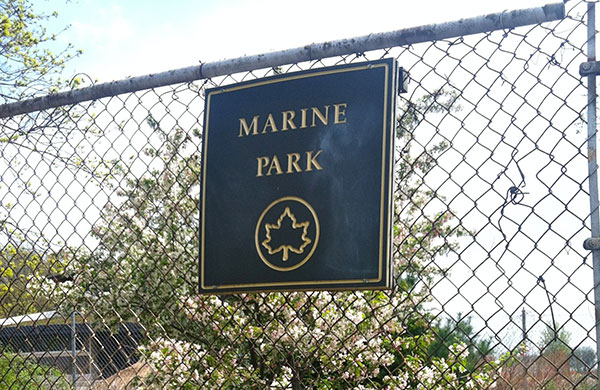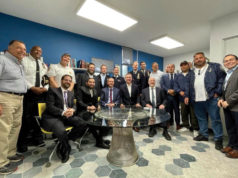

There are over 1,500 parks in the New York City area. Some of them are immense in size and others are quite small. The most commonly known parks in the New York City area are Central Park, Prospect Park, Bryant Park, and Washington Square Park. However, there is another park that is lesser-known which is in South Brooklyn. The park is one of the largest in the New York City area and takes up almost 800 acres of land. This park is called Marine Park.
The neighborhood around the actual park is also called Marine Park. It has a population of just under 95,000 residents who are mainly of Irish, Italian, Greek, and Jewish descent. The neighborhood is known for celebrating many Irish Catholic events and has many Roman Catholic churches around the neighborhood.
When compared to many other parks in New York City, Marine Park is typically never really mentioned. This is due to the overall popularity of Manhattan parks and the name recognition and publicity that Prospect Park receives. But wait! If you look at Marine Park’s history, you will be intrigued to learn about a little secret that is almost never mentioned by anyone.

Marine Park’s journey began in 1911 when two designers, Daniel Burnham and Edward Bennett, were asked to design a blueprint to expand Brooklyn’s southern borders. At the same time, two prominent philanthropists, Frederic B. Pratt and Alfred T. White, purchased about 100 acres of land so that a park can be created. After years of negotiations both philanthropists agreed to pay for all of the costs related to constructing the park. Both Burnham and Bennett believed that a park would increase real-estate value for homeowners and convince more people to move to the area. Eventually, the League for the Improvement of Marine Park was established and by 1925, Marine Park was officially a park of New York City.
Over the next few years, several politicians attempted to expand the size of Marine Park. Both Sol Bloom and Jimmy Walker wanted to celebrate the two-hundredth anniversary of George Washington’s birth. They wanted to construct a stadium with capacity for two-hundred thousand people. In the end, politicians and local community planners installed several baseball diamonds instead. Fortunately, the project still had extra funds on the side which were never touched.
By 1930, New York politicians still had high hopes for Marine Park. Several million dollars were set aside for the park and a prestigious architect named Charles Downing Lay became the head designer of Marine Park. Lay spent much of his childhood in Stratford, Connecticut fishing and sailing. Over time he developed a great appreciation for nature. Lay attended the School of Architecture at Columbia University and then transferred to Harvard University. He graduated with a Bachelor of Science in 1902, making him the second man to achieve a degree in the field of architecture.

In 1910, he formed a partnership with several other architects and opened a landscape architecture firm in Manhattan. They then began publishing the professional journal Landscape Architecture that same year. Lay worked as a manager and editor up until 1921. Lay held positions with the New York City Park’s Department, the U.S. Housing Corporation, and eventually the U.S. Navy where he designed and developed military installations during World War II.
When Lay took the job as head designer of Marine Park, he envisioned the park becoming the premier park of New York City. Lay wanted the park to be larger than Prospect and Central combined. Marine Park would have a football stadium fit to hold 125,000 people. Moreover, there would be hundreds of tennis courts, an eighteen-hole golf course, a zoo, a casino, swimming pools, and slips for yachts.[1]
According to some scholars, the budget for the project ballooned to a whopping $40 million. Remember, this project included all of the surrounding areas of Marine Park (including pristine marshland around Gerritsen Creek). Eventually the project expanded to around 1,800 acres. Although this all may sound surreal, Lay was extremely serious about the project. Ultimately, Robert Moses, one of the most influential “master builders” of New York City, had other priorities and began to abandon the extravagant plans for Marine Park. Furthermore, Moses strongly believed that the project’s overall cost may have eventually reached over $50 million.
So, you may be asking was that the big secret about Marine Park? Nope. During the summer of 1936, Nazi Germany hosted the Olympics (Adolf Hitler had come to power just three years before and attempted to use the Olympics as a tool to show the world that Germany can compete on a global scale.) Furthermore, Germany wanted to outdo the Summer Olympics of 1932 (which were held in Los Angeles, California). For the 1936 Olympics Germany constructed a brand-new 100,000 seat stadium, six gymnasiums, high tech TVs and radios, and a few smaller arenas as well.

At first, American politicians were hesitant for American athletes to participate in the Olympics, especially because Nazi Germany already opened up concentration camps such as Dachau as early as 1933. In the end, the U.S. decided to participate in the Olympics. Apart from the athletes competing in various sports, the Berlin Olympics offered another event to international competitors as well. Medals were awarded in five categories which included architecture, literature, painting, music, and sculpting. The winner of these events would receive a gold, silver, or bronze medal. The competition lasted from July 15 to August 16 and displayed works from 22 different countries.
Many American professionals (primarily architects, musicians, and painters) were extraordinarily dubious of the judging process because of the high amount of German-speaking applicants. They believed that non-German speaking candidates had virtually no chance of winning any medal whatsoever. Furthermore, many historians conclude that judges at the Olympics may have been fearful of Hitler. It was also believed that judges were forced to favor German and German-speaking applicants which would increase the overall amount of German medals awarded.
On August 8, 1936, Austria (Hitler’s birthplace) competed against Peru in a highly contested football game. Peru defeated Austria 4-2. Hitler was livid that a South American team had defeated the Austrians. Hitler and other Nazis demanded a rematch after thinking that Peru had cheated.

The Peruvian football team left the field after refusing to play in a rematch against Austria. The Colombian team supported Peru by following them to the locker room. Austria had won the match because Peru officially forfeited (by never playing the second game that the Nazis demanded).

American athletes including Jesse Owens, competed and represented the United States. Hitler wanted to show everyone at the games that the resurgence of Nazi Germany would challenge any nation, in any sport. The fact that Jesse Owens was an African-American greatly frustrated Hitler and other Nazis in the audience. Hitler believed that all sports events would be dominated solely by “Aryan” athletes. Jesse Owens would go on to win four gold metals in the 1936 Summer Olympics. Clearly, Hitler was distraught that German athletes failed to win those events.[2]

After tremendous hesitation, Lay eventually decided to enter the architecture competition. Lay knew that his chances of winning a medal were slim to none, but he felt it was worth a shot. He knew that the Berlin Olympic Stadium (Reich Sport Field) was designed by Werner March and his brother Walter March. On top of that, their father Otto March designed the stadium that was supposed to be used during the 1916 Olympics in Berlin (they were cancelled that year due to the First World War).
According to some German historians, both of the March brothers focused on designs which specifically catered to Albert Speer, an architect who later became the Minister of Armaments and War Production. Hitler and Speer were very close friends, therefore, the March brothers were under immense pressure when designing the stadium. They worked for many years on this project making sure that it would come out completely flawless.
Lay knew it was a longshot and entered Marine Park into the architectural design/municipal planning part of the competition. This was the one time in its history that Marine Park had the opportunity to be seen on an international scale.
The gold medal was awarded to Werner March and his brother Walter March for designing the Berlin Olympic Stadium (Reich Sport Field). The bronze medal went to Theo Nussbaum for designing the Municipal Planning and Sporting Center in Cologne, Germany. Lastly, the silver medal went to Charles Lay for designing Marine Park, in Brooklyn, New York. Many scholars will agree that some high-ranking Nazi officers even heard Marine Park’s name pronounced out loud, and they were surprised that an American architectural participant had won a medal.
Out of all the medals awarded around 90% would go to either German-speaking nations or nations with political ties to Nazi Germany. Out of the non-sports related competitions, Germany would receive an astonishing 12 medals in all. Austria and Italy would win 9 medals combined. The United States would only win one medal, the silver medal of architectural design/municipal planning (Lay’s design of Marine Park).
When the Olympics ended, a League member wrote to Moses in 1940 asking if it might be a good idea to push for the 1944 Olympics to be held in Marine Park, Brooklyn. Moses was preoccupied with projects related to Riis Park and the Marine Parkway-Gil Hodges Memorial Bridge. He also had major projects with the Marine Parkway Authority which was a huge source of income for him. By the early 1940s, Marine Park’s dreams of becoming a behemoth Olympic stadium were pretty much shattered.
Some of the areas that Moses changed for the worst were Coney Island and the South Bronx. He also caused the departure of both the Brooklyn Dodgers and New York Giants. Many of his critics believe that his emphasis on highways led to the neglect and divestment of the proposed expansion of the New York City subway system. Some experts believe that the 2 and 5 subway lines were supposed to eventually link up to the Marine Park/Gerritsen area. This proposed expansion plan would have made traveling easier for residents in these areas. Currently buses are the only way to travel through these neighborhoods.
Many scholars would agree that Moses preferred “automobiles over people”. They point out that he displaced hundreds of thousands of residents in New York City and destroyed traditional neighborhoods by building expressways directly through them. This ultimately put the final nail in the coffin for Marine Park’s massive expansion plans.[3]

Today, the only trace of a colossal stadium that remains are the running and biking tracks, surrounded by quiet trees, and baseball fields in the center. The park was once called the number one “forgotten development” in a postwar edition of the Brooklyn Daily Eagle.
Even though it never became an internationally-known gargantuan stadium with a zoo, a casino, and several Olympic size swimming pools, you shouldn’t get depressed when thinking about what Marine Park “could have turned out to be”. Today, it is still a gorgeous park with a beautiful nature center sitting on one of Brooklyn’s most exquisite salt marshes (It consists of 530 acres of protected grassland and precious salt marsh which hosts 325 species of birds, 50 species of butterflies, and 100 species of finfish). The park offers activities such as canoeing, biking, and kayaking. You can also find handball and tennis courts, two playgrounds for children, bocce ball courts, and basketball courts.

Getting to Marine Park isn’t that difficult either. You can take the B or Q train down to Kings Highway. Get off there, find the B2 or B100 bus on Quentin Road, and ride that another fifteen minutes east, and you’ll find Marine Park. You can also take the 2 or 5 train there from Manhattan (although a bus transfer will be needed).

From now on, if you are driving by, biking or walking around Marine Park with your friends or family, tell them that Central, Prospect, Bryant, and Washington Square Park are not the greatest parks to visit in New York City. Be sure to tell them that one of the greatest parks in New York City is Marine Park. In addition, explain Marine Park’s history to them and how it was the only park in American history to compete internationally in the Olympics because they too, should know about this fascinating little secret.




